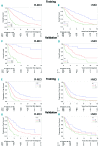A concise revised Myeloma Comorbidity Index as a valid prognostic instrument in a large cohort of 801 multiple myeloma patients
- PMID: 28154088
- PMCID: PMC5477610
- DOI: 10.3324/haematol.2016.162693
A concise revised Myeloma Comorbidity Index as a valid prognostic instrument in a large cohort of 801 multiple myeloma patients
Abstract
With growing numbers of elderly multiple myeloma patients, reliable tools to assess their vulnerability are required. The objective of the analysis herein was to develop and validate an easy to use myeloma risk score (revised Myeloma Comorbidity Index) that allows for risk prediction of overall survival and progression-free survival differences in a large patient cohort. We conducted a comprehensive comorbidity, frailty and disability evaluation in 801 consecutive myeloma patients, including comorbidity risks obtained at diagnosis. The cohort was examined within a training and validation set. Multivariate analysis determined renal, lung and Karnofsky Performance Status impairment, frailty and age as significant risks for overall survival. These were combined in a weighted revised Myeloma Comorbidity Index, allowing for the identification of fit (revised Myeloma Comorbidity Index ≤3 [n=247, 30.8%]), intermediate-fit (revised Myeloma Comorbidity Index 4-6 [n=446, 55.7%]) and frail patients (revised Myeloma Comorbidity Index >6 [n=108, 13.5%]): these subgroups, confirmed via validation analysis, showed median overall survival rates of 10.1, 4.4 and 1.2 years, respectively. The revised Myeloma Comorbidity Index was compared to other commonly used comorbidity indices (Charlson Comorbidity Index, Hematopoietic Cell Transplantation-Specific Comorbidity Index, Kaplan-Feinstein Index): if each were divided in risk groups based on 25% and 75% quartiles, highest hazard ratios, best prediction and Brier scores were achieved with the revised Myeloma Comorbidity Index. The advantages of the revised Myeloma Comorbidity Index include its accurate assessment of patients' physical conditions and simple clinical applicability. We propose the revised Myeloma Comorbidity Index to be tested with the "reference" International Myeloma Working Group frailty score in multicenter analyses and future clinical trials. The study was registered at the German Clinical Trials Register (DRKS-00003868).
Copyright© Ferrata Storti Foundation.
Figures




References
-
- Palumbo A, Bringhen S, Ludwig H, et al. Personalized therapy in multiple myeloma according to patient age and vulnerability: a report of the European Myeloma Network (EMN). Blood. 2011;118(17):4519–4529. - PubMed
Publication types
MeSH terms
LinkOut - more resources
Full Text Sources
Other Literature Sources
Medical

